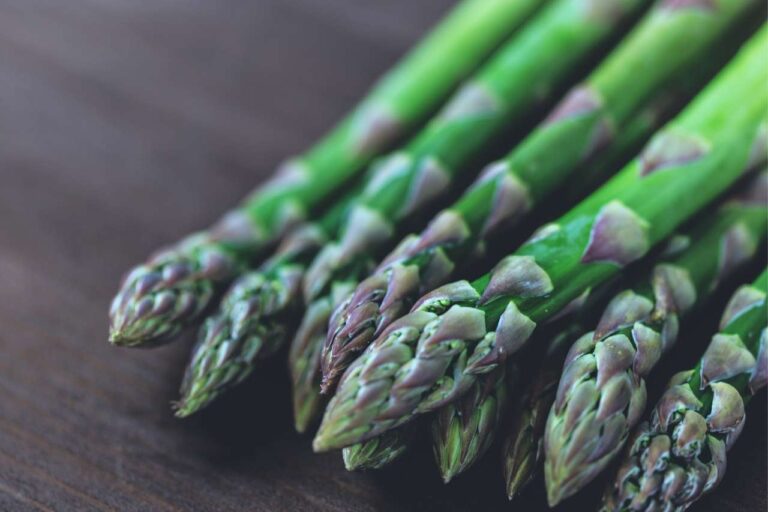
You may be curious, what part of asparagus do you eat. This guide will teach you about the different portions of asparagus that must get consumed. Asparagus is a common ingredient in many dishes. Despite the excellent nutritional content of this vegetable, determining which pieces to consume might be difficult.
When some sections of asparagus get ingested, they might create digestive difficulties, so it’s vital to recognize which portion is acceptable and which isn’t. If you’re new to consuming this delicious crop, you’re in for a treat.
It’s no surprise that several individuals have unknowingly discarded eatable asparagus portions. While it’s not entirely their fault, no one wants to squander such nutrient-dense produce.
Quick Summary: Immature sensitive shoots or buds, spears, and meaty stalks are the components of asparagus you consume. These sections are frequently consumed raw in salads and cooked, barbecued, and roasted. So when the vegetable is at least two years old and around 6 to 10 inches tall, it is the most delicate time to pick these components.
Read more about which sections of asparagus to eat and cook this vegetable.
Asparagus is a healthy green vegetable with hollowed stalks that goes well with almost any cuisine. The sole drawback of this plant is that it might be difficult to distinguish between eatable and non-eatable sections. Let’s look at what part of asparagus do you eat.
What Part Of Asparagus Do You Eat?
Because the whole stem of asparagus is not eatable, it is critical to understand which parts of the vegetable are eatable to enhance its flavor.
Stems
An asparagus stalk is a portion of the plant that emerges above the soil. When putting asparagus into your preferred marinade, that’s the section you generally hold. It begins with the hardened tip, which must get removed to prolong the asparagus’s viability. To prevent the vegetable from losing its flavor, trim the greenish-white fibers in the stalks.
Buds
The tip of the asparagus vegetable gets distinguished by small leaves known as scale leaflets. It usually is around 1.27 cm long and can get used in salads. When scraped, they are ideal for seasoning.
Shoots
You can consume the spears intact; however, if you don’t want your dish coated in rough strands, peel them when preparing.
Can You Consume All Parts Of Asparagus?
When some sections of asparagus get consumed, they may cause stomach problems. The spears, stalk, and blossom are all edible and barely 15 cm long. Asparagus also contains asparagine, which often gives meals their characteristic tastes.
Asparagus may be enjoyed at any development stage and consumed uncooked. Early asparagus stalks get consumed in several areas, such as Europe. Asparagus is consumed fresh, scraped, or cooked once it grows.
Note: It isn’t a good idea to consume raw asparagus stems since too many of them might cause organ failure. Asparagus even has a component that gets seldom discussed: the fruit. Although the stems are edible, the vivid red cherries are harmful to our human body.
The asparagus’s base portion is not edible. It is a rough component with a nasty taste that you don’t like on your tongue. This section gets readily removed by twisting the asparagus stalk downward until it breaks.
Asparagus roots are another non-edible portion that must get removed before cooking since they are prone to stiffen. The tubers are very nasty and straggly, so no one wants to bite into them.
Fairly thick asparagus stems have a gritty feel, indicating more protein in your recipes. If you find any black areas on the asparagus stalk, eliminate them.
Can You Use Pellets in A Regular Smoker? Read HERE.
Parts of Asparagus you Could eat
Asparagus is a fingertip food, and also the stalk gets frequently eaten. It gets regarded as a delicacy vegetable owing to its low-fat level and medium nutrient content.
The asparagus stalk gets made up of two parts: the shoot and the bud, which are edible, and the bottom section and the tubers, which are not. Young asparagus shoots may get found at your local food shop. Many individuals swallow the upper half to get vitamin C and K.
For what part of asparagus do you eat? Because it is not dangerous, the bottom half of the asparagus may also get eaten. The primary drawbacks to this section are the harsh flavor and the several stringy strands. After peeling, this section can get consumed with a bit of ketchup.
How to Prepare Asparagus
- Rinse the asparagus stalks to eliminate any grit or grease.
- Slice the stalk 2 inches (five cm) well above the point where that joins the vegetable.
- Rinse it again and allow the water to flow.
- Use your hands or a knife to cut the prickly portions of the stems.
- Prepare your asparagus as desired, or keep it in the fridge for subsequent use.
Note: When the outer sections of the asparagus are gooey brownish, and the stalks are floppy, you’ve overdone it. When you stab one of the shoots with a fork, it cracks in two with no effort. Overbaked asparagus does have a mushy appearance and a unique tart flavor.
The portion you should chop off of Asparagus
Preferably, cut around 7.6 cm of asparagus out from the main base. It should be plenty of yummy stems for you to savor in your dish. To prevent bitterness, cut off the bottom end of the vegetable when simmering. What leaves is a delicious meaty stem that is delicious when fried.
Bottom Line
Asparagus is considered a delicacy by some. Others may love it solely for its dietary benefits and taste. It is critical to understand that around six inches of asparagus are eatable. The spongy stalks, spears, and any connected leaves are examples of these components. The wooden bottom half doesn’t get eaten since it is stringier than other portions. Importantly, before cooking this vegetable, you need to remove around 3 inches of the bottom end.